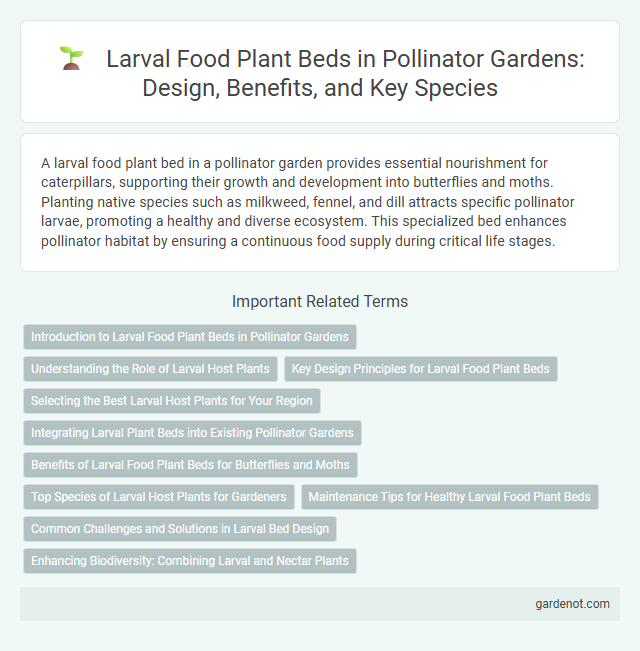A larval food plant bed in a pollinator garden provides essential nourishment for caterpillars, supporting their growth and development into butterflies and moths. Planting native species such as milkweed, fennel, and dill attracts specific pollinator larvae, promoting a healthy and diverse ecosystem. This specialized bed enhances pollinator habitat by ensuring a continuous food supply during critical life stages.
Introduction to Larval Food Plant Beds in Pollinator Gardens
Larval food plant beds are essential habitats in pollinator gardens, providing targeted nutrition for butterfly and moth caterpillars during their critical growth stages. These specialized beds typically include host plants such as milkweed for monarch larvae and parsley for swallowtail caterpillars, promoting successful metamorphosis and sustaining pollinator populations. Integrating diverse native plant species in larval food plant beds enhances biodiversity and supports local ecosystem health by ensuring food availability for developing larvae.
Understanding the Role of Larval Host Plants
Larval host plants provide essential nutrients and habitat for butterfly and moth larvae, supporting their growth and survival through critical developmental stages. Selecting native species such as milkweed for monarchs or nettles for red admirals ensures a healthy pollinator garden ecosystem by fostering higher caterpillar populations. Properly maintained larval food plant beds contribute to the biodiversity and resilience of pollinator habitats, enhancing pollination services and ecological balance.
Key Design Principles for Larval Food Plant Beds
Larval food plant beds should prioritize native host plants that support specific butterfly and moth species during their developmental stages. Incorporating a diverse range of plant species with staggered bloom times ensures continuous food availability and habitat throughout the growing season. Design principles emphasize proper spacing for airflow, sun exposure, and protection from predators to maximize larval survival and growth.
Selecting the Best Larval Host Plants for Your Region
Choosing the best larval host plants for your region is essential to support native pollinator populations and ensure their lifecycle completion. Prioritize local species that cater to the specific butterfly and moth larvae in your area, such as milkweed for monarchs or fennel for swallowtails. Incorporating a diverse mix of native plants enhances habitat suitability, promotes biodiversity, and fosters a resilient pollinator garden ecosystem.
Integrating Larval Plant Beds into Existing Pollinator Gardens
Integrating larval food plant beds into existing pollinator gardens enhances habitat diversity and supports butterfly and moth populations by providing essential host plants for their larvae. Key species such as milkweed, fennel, and parsley serve as primary larval food sources that increase pollinator garden resilience and biodiversity. Designing these beds with native plants tailored to local butterfly species optimizes larval survival rates and promotes a balanced pollinator ecosystem.
Benefits of Larval Food Plant Beds for Butterflies and Moths
Larval food plant beds provide essential nourishment for butterfly and moth caterpillars, supporting their development and increasing survival rates. These specialized habitats promote biodiversity by sustaining native species and enhancing pollinator populations. Incorporating larval food plants into gardens helps maintain ecological balance and contributes to the conservation of vulnerable butterfly and moth species.
Top Species of Larval Host Plants for Gardeners
Top species of larval host plants for pollinator gardens include milkweed (Asclepias spp.), essential for monarch butterfly caterpillars, and dill (Anethum graveolens), which supports black swallowtail larvae. Passionflower (Passiflora incarnata) serves as a critical food source for Gulf fritillary butterflies, while violets (Viola spp.) nourish fritillary caterpillars. Incorporating these larval food plant beds enhances butterfly reproduction and supports diverse pollinator populations.
Maintenance Tips for Healthy Larval Food Plant Beds
Regular watering and mulching help maintain soil moisture and reduce weed growth in larval food plant beds. Pruning dead or damaged plant parts encourages healthy growth and maximizes food availability for caterpillars. Monitoring for pests and diseases early ensures timely intervention and prevents damage to essential larval food sources.
Common Challenges and Solutions in Larval Bed Design
Common challenges in larval food plant bed design include selecting host plants that support diverse butterfly and moth species while preventing invasive species from overtaking the bed. Ensuring proper soil moisture and avoiding pesticide use are critical to maintaining healthy larval habitats. Solutions involve using native host plants, implementing companion planting to deter pests naturally, and designing beds with varied microhabitats to optimize larval survival and growth.
Enhancing Biodiversity: Combining Larval and Nectar Plants
A larval food plant bed supports caterpillar growth by providing essential host plants while integrating nectar-rich flowers attracts adult pollinators, creating a synergistic habitat that boosts pollinator diversity. Selecting native species such as milkweed, fennel, and goldenrod ensures optimal food sources for both larvae and adults, promoting local ecosystem health. This strategic planting enhances biodiversity by sustaining multiple life stages of pollinators, contributing to a balanced and resilient garden environment.
Larval food plant bed Infographic

 gardenot.com
gardenot.com